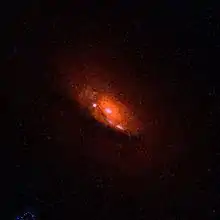3C 236
3C 236 is a Fanaroff and Riley Class II (FR II) radio galaxy. It is among the largest known radio galaxies, with the radio structure having a total linear size in excess of 4.5 Mpc (15 million light years); this makes it the second largest object known in the universe. The galaxy features a "double-double" radio morphology consisting of the giant relic 4.5 Mpc source and an inner 2 kpc compact steep spectrum radio source. A recent starburst episode near the nucleus may be related to the event resulting in re-ignition of radio activity .[2]
| 3C 236 North | |
|---|---|
 | |
| Observation data (J2000 epoch) | |
| Constellation | Leo Minor |
| Right ascension | 10h 06m 01.7s[1] |
| Declination | +34° 54′ 10″[1] |
| Redshift | 0.1005 (NED)[1] |
| Distance | 1.3 billion light-years (Light travel time)[1] |
| Apparent magnitude (V) | 16.4g[1] |
| Characteristics | |
| Type | WLRG;LERG[1] |
| Apparent size (V) | 0′.46 × 0′.38[1] |
| Other designations | |
| PGC 29329,[1] LEDA 29329 , 7C 1003+3508 , 4C 35.22 | |
External links
- PHYSORG
- Harvard
- Spitzer at Caltech
- NASA
- JPL
- Universe Today
- NRAO
- 3C 236 on WikiSky: DSS2, SDSS, GALEX, IRAS, Hydrogen α, X-Ray, Astrophoto, Sky Map, Articles and images
References
- "NASA/IPAC Extragalactic Database". Results for 3C 236. Retrieved 2008-07-19.
- Tremblay, Grant R.; O'Dea, Christopher P.; Baum, Stefi A.; Koekemoer, Anton M.; Sparks, William B.; de Bruyn, Ger; Schoenmakers, Arno P. (April 2010), "Episodic Star Formation Coupled to Reignition of Radio Activity in 3C 236", The Astrophysical Journal, 715: 172, arXiv:1004.0388, Bibcode:2010ApJ...715..172T, doi:10.1088/0004-637X/715/1/172
This article is issued from Wikipedia. The text is licensed under Creative Commons - Attribution - Sharealike. Additional terms may apply for the media files.